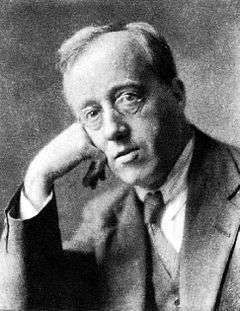The Perfect Fool
| Operas by Gustav Holst |
|---|
 |
|
The Perfect Fool is an opera in one act with music and libretto by the English composer Gustav Holst. Holst composed the work over the period of 1918 to 1922. The opera received its premiere at the Covent Garden Theatre, London on 14 May 1923. Holst had originally asked Clifford Bax to write the libretto, but Bax declined.[1]
In the score, Holst pokes fun at the works of Verdi, Wagner's Parsifal[2] and Debussy. In the opera, the part of the Fool consists of only one word. One interpretation of possible symbolism of the opera, from Donald Tovey, is that the Princess symbolises the world of opera and the Fool represents the British public.[3]
The opera was not a success, and audiences had found the story confusing.[4] Although the opera did receive a live BBC broadcast a year after its premiere,[5] revivals of the work have been rare. In 1995, Vernon Handley conducted a performance of the complete opera for the BBC, broadcast on 25 December.[6]
Ballet music
The introductory ballet music is much more often performed, separately as a suite. The ballet music falls into the following sections:
- Andante (invocation)
- Dance of Spirits of Earth (Moderato – Andante)
- Dance of Spirits of Water (Allegro)
- Dance of Spirits of Fire (Allegro moderato – Andante)
Themes from the ballet music recur throughout the remainder of the opera.[3]
Roles
| Role | Voice type | Premiere Cast, 14 May 1923(Conductor: Eugene Goossens) |
|---|---|---|
| Fool/Farmer | spoken role | Raymond Ellis |
| Wizard | baritone | Robert Parker |
| Troubadour | tenor | Walter Hyde |
| Traveller | bass | Frederick Collier |
| Princess | soprano | Maggie Teyte |
| Fool's mother | contralto | Edna Thornton |
Instrumentation
- Woodwind: piccolo, 2 flutes, 2 oboes, english horn, 2 clarinets, bass clarinet, 2 bassoons and a contrabassoon
- Brass: 4 horns in F, 4 trumpets in C, 3 trombones (2 tenor and 1 bass) and a tuba
- Keyboards: a celesta
- Percussion: 3 timpani, a bass drum, cymbals (suspended and clash), a tam-tam, sleigh bells, a tambourine and a xylophone.
- Strings: a harp, 1st and 2nd violins, violas, violoncellos, and double basses
References
- Notes
- ↑ Bax, Clifford (January 1939). "Recollections of Gustav Holst". Music & Letters. 20 (1): 1–6. doi:10.1093/ml/20.1.1. JSTOR 728520.
- ↑ Head, Raymond (July 1999). "The Hymn of Jesus: Holst's Gnostic Exploration of Time and Space". Tempo (New Series). Musical Times Publications Ltd. 209 (1576): 7–13. JSTOR 957953.
- 1 2 Ottaway, Hugh (June 1974). "Holst as an opera composer". The Musical Times. Musical Times Publications Ltd. 115 (1576): 473–474. doi:10.2307/957953. JSTOR 957953.
- ↑ Holmes, p. 90
- ↑ Holmes, p. 94.
- ↑ Northcott, Bayan (29 December 1995). "On another planet". The Independent. London. Retrieved 4 July 2014.
- Sources
- Holden, Amanda (Ed.), The New Penguin Opera Guide, New York: Penguin Putnam, 2001. ISBN 0-14-029312-4
- Holmes, Paul, Holst. Omnibus Press, 1998 ISBN 978-0-7119-6525-6
External links
- The Perfect Fool Opera — Three selections from the opera.
- Chester Novello page on The Perfect Fool
- Casaglia, Gherardo (2005).[http://www.amadeusonline.net/almanacco?r=&alm_giorno=14&alm_mese=05&alm_anno=1923&alm_testo=The_Perfect_Fool "The Perfect Fool, 14 May 1923"]. Almanacco Amadeus (Italian).